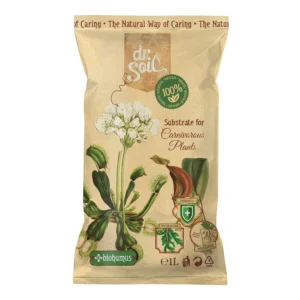Water as needed.
Storage conditions:
Keep the vegetable compost in a dry place, in the original packaging. Keep out of children reach.
Throw the packaging in the blue bin. Validity period: unlimited
 Natural Soil Substrate for Citrus, Dr.Soil1 L
€ 6.24
Natural Soil Substrate for Citrus, Dr.Soil1 L
€ 6.24
 Natural Soil Substrate for Carnivorous Plants, Dr.Soil 1L
€ 6.24
Natural Soil Substrate for Carnivorous Plants, Dr.Soil 1L
€ 6.24
€ 6.24
Natural substrate for Bonsai, preferably with biohumus, per 1L bag Composition: peat, biohumus, humus from Mediterranean pine bark min. 15%, vermiculite, expanded red ceramic granules, organic matter This formula satisfies the main needs of Bonsai and other plants resulting from cutting or any other cultivation techniques: additional drainage and aeration, low conditions for the development of molds, fertilization and natural immunity. Instructions for use: Choose a suitable tray and place some pebbles at the base to ensure good water drainage. Then pour a layer of substrate and prepare a hole to place the new plant. Carefully remove the plant from the old pot and gently remove any existing soil on the roots. Place the plant in the new tray, cover the roots with substrate and press gently and evenly around the plant. Water the plant sparingly.
Out of stock
Notify me when the item is back in stock.
Water as needed.
Storage conditions:
Keep the vegetable compost in a dry place, in the original packaging. Keep out of children reach.
Throw the packaging in the blue bin. Validity period: unlimited